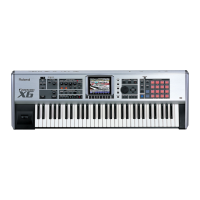55
Playing in Piano Mode
2.
Use the VALUE dial or [DEC][INC] to specify the desired
touch.
•
Light:
This sets the keyboard to a light touch. You can achieve
fortissimo (ff) play with a less forceful touch than usual,
so the keyboard feels lighter. This setting makes it
easier for children, whose hands have less strength.
•
Medium:
This sets the keyboard to the standard touch. You
can play with the most natural touch. This setting is
closest to the response of an acoustic piano.
•
Heavy:
This sets the keyboard to a heavy touch. You have to
play the keyboard more forcefully than usual in
order to play fortissimo (ff), so the keyboard touch
feels heavier. This setting allows you to add more
expression when playing dynamically.
1.
In the Piano Mode screen, press [F3 (Open/Close)].
fig.27-003_50
2.
Use the VALUE dial or [DEC][INC] to change the setting,
simulating the way in which the sound changes when you
open or close the lid of a grand piano.
Value:
1–6
When you hold down the damper pedal on an acoustic piano, the
strings (notes) you play will cause the other strings to resonate
sympathetically, creating a rich and spacious resonance. You can
adjust the depth of this resonance.
1.
From the Piano Mode screen, press [F4 (Resonance)].
fig.27-005_50
2.
Either turn the VALUE dial or use [INC] [DEC] to set the
value.
You can press a button [F4]–[F8] to access multi-effects that are
frequently used on electric pianos.
Knobs 1–4 displayed in the screen correspond to REALTIME
CONTROL knobs 1–4.
[F4 (Tremolo)]: Tremolo
[F5 (Chorus)]: Chorus
[F6 (Phaser)]: Phaser
[F7 (EQ)]: Equalizer
[F8 (Speaker SIM)]: Speaker simulator
Changes you make to sound settings are temporary, and will be lost
if you turn off the power or select another sound. If you want to keep
the modified sound, you must save it in the internal USER group
(user memory). Refer to
“Saving Patches You’ve Created (Write)”
(p. 59).
Changing the Piano Sound
(Open/Close)
Adjusting the Depth of Resonance
(Resonance)
Playing electric piano
sounds
Selecting electric piano effects
Saving a Sound (Patch)
Fantom-X678_r_e.book 55 ページ 2005年5月12日 木曜日 午後4時40分

